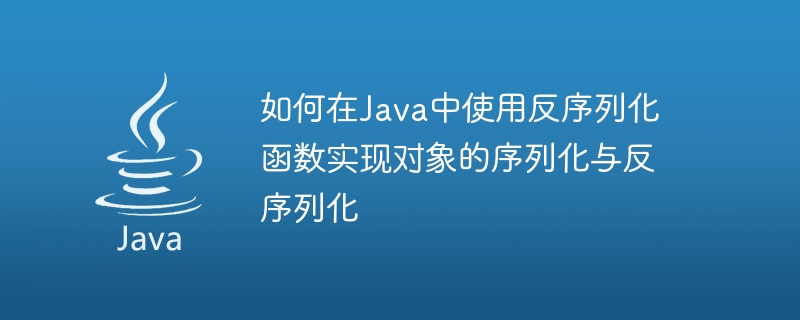如何在Java中使用反序列化函数实现对象的序列化与反序列化
- WBOYWBOYWBOYWBOYWBOYWBOYWBOYWBOYWBOYWBOYWBOYWBOYWB原创
- 2023-10-20 15:31:461070浏览

如何在Java中使用反序列化函数实现对象的序列化与反序列化
序列化是将对象转换为可以在网络传输或存储中使用的字节流的过程,而反序列化则是将字节流转换回对象的过程。Java提供了序列化和反序列化的机制,使得开发者可以方便地将对象进行存储和传输。本文将介绍如何在Java中使用反序列化函数实现对象的序列化和反序列化,并给出具体的代码示例。
- 实现Serializable接口
要实现对象的序列化和反序列化,首先需要确保被序列化的对象所属的类实现了Serializable接口。该接口没有任何方法,只是起到一个标识的作用,告诉Java这个类可以被序列化。
示例代码:
import java.io.Serializable;
public class Person implements Serializable {
private String name;
private int age;
public Person(String name, int age) {
this.name = name;
this.age = age;
}
// getter and setter
}- 对象的序列化
要将一个对象序列化为字节流,可以使用ObjectOutputStream类。首先需要创建一个FileOutputStream对象,将其作为参数传递给ObjectOutputStream的构造函数,然后使用ObjectOutputStream的writeObject方法将对象写入文件。
示例代码:
import java.io.FileOutputStream;
import java.io.ObjectOutputStream;
public class SerializationDemo {
public static void main(String[] args) {
Person person = new Person("张三", 25);
try {
FileOutputStream fileOut = new FileOutputStream("person.ser");
ObjectOutputStream out = new ObjectOutputStream(fileOut);
out.writeObject(person);
out.close();
fileOut.close();
System.out.println("对象已被序列化并保存在person.ser文件中");
} catch (Exception e) {
e.printStackTrace();
}
}
}- 对象的反序列化
要将一个字节流反序列化为对象,可以使用ObjectInputStream类。首先需要创建一个FileInputStream对象,将其作为参数传递给ObjectInputStream的构造函数,然后使用ObjectInputStream的readObject方法将文件中的字节流读取为一个对象。
示例代码:
import java.io.FileInputStream;
import java.io.ObjectInputStream;
public class DeserializationDemo {
public static void main(String[] args) {
Person person = null;
try {
FileInputStream fileIn = new FileInputStream("person.ser");
ObjectInputStream in = new ObjectInputStream(fileIn);
person = (Person) in.readObject();
in.close();
fileIn.close();
} catch (Exception e) {
e.printStackTrace();
}
if (person != null) {
System.out.println("对象已经从person.ser文件中反序列化:" + person.getName() + "," + person.getAge());
}
}
}以上就是在Java中使用反序列化函数实现对象的序列化与反序列化的方法和代码示例。通过实现Serializable接口和使用ObjectInputStream和ObjectOutputStream类,我们可以轻松地将对象序列化为字节流,或将字节流反序列化回对象。这一机制在网络传输和文件存储中都具有很大的应用价值。
以上是如何在Java中使用反序列化函数实现对象的序列化与反序列化的详细内容。更多信息请关注PHP中文网其他相关文章!
声明:
本文内容由网友自发贡献,版权归原作者所有,本站不承担相应法律责任。如您发现有涉嫌抄袭侵权的内容,请联系admin@php.cn

